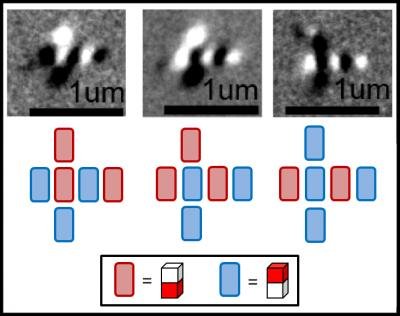
Tiny magnetic memory and logic devices that consume very little energy have been developed by researchers at the University of California, Berkeley. With further improvements, the devices could operate close to the “Landauer limit” of minimum energy consumption because they require no moving electrons to work – something that could revolutionize electronics.
Half a century ago the IBM physicist Rolf Landauer was the first to establish that information and computation are physical processes. He also showed that, contrary to the received wisdom at the time, performing computations does not require a minimum amount of energy but that erasing information does.
He used the newly developed information theory to calculate the minimum amount of energy that a logical operation (such as an AND or OR operation) would consume, given the limitations imposed by the second law of thermodynamics. This law states that an irreversible process – such as a logical operation or erasing a bit of information – dissipates energy that can never be recovered from the system. The minimum amount of energy was calculated to be 18 meV at room temperature, which is now known as the Landauer limit.
No moving electrons
Modern-day silicon-based computing chips rely on electric currents that unfortunately produce a lot of waste heat – mainly through the electrical resistance of moving electrons. However, microprocessors based on just nanomagnets would, in principle, require no moving electrons and so waste significantly less energy during operation. According to calculations performed by the researchers, such chips would dissipate energy at the Landauer limit during erasure operations. This is a million times less energy per operation than today’s computers require.
“One could, I think, build real circuits that would operate right at the Landauer limit,” says team leader Jeffrey Bokor. “Even if we could get within one order of magnitude, a factor of 10, of this limit, it would represent a huge reduction in energy consumption for electronics. It would be absolutely revolutionary.”
The nanomagnets employed by Bokor and colleagues are roughly 100 nm wide and 200 nm long. They can be used in binary computer memory thanks to the fact that the up and down orientation of the magnetic poles (north or south) can be used to represent “0” and “1”. More importantly, if multiple nanomagnets are packed close together, their north and south poles interact via ordinary dipole–dipole forces and so behave like transistors, something that allows for simple logic operations. Indeed, the researchers calculated that computation in a circuit consisting of 16 coupled nanomagnets would also dissipate energy at the Landauer limit.
However, there is still much to do before such nanomagnetic memories and logic see the light of day. For one thing, scientists need to find a way of dispensing with electrical currents altogether in such systems – at present, these currents are used to generate a magnetic field that erases or flips the polarity of the nanomagnet. “Ideally, new materials will make electrical currents unnecessary, except perhaps for relaying information from one chip to another,” explains Bokor.
Finding the right materials
The team is now working with several other research groups to find such materials. “For example, multiferroics show promise because you can use them to control magnetism directly with a voltage rather than an external magnetic field,” adds Bokor.
Another big problem will be to make the devices less susceptible to random fluctuations – such as thermal effects, stray magnetic fields and other types of noise – from the environment. Such a problem is inevitable in small devices that run on extremely low power.
“This is a very exciting paper,” Owen Maroney from Oxford University in the UK, who was not involved in the work, told physicsworld.com. “The models we use to derive the Landauer limit have often been so abstract that we worried that something might stop real physical systems from reaching it. It is great to see the technology developing to the point where building a scalable computer that operates in this way is looking like a realistic possibility. While there are clearly still a few more hurdles to pass, the result shows how developing nanoscience can lead to great benefits.”
The work was reported in Phys. Rev. Lett. 107 010604.



